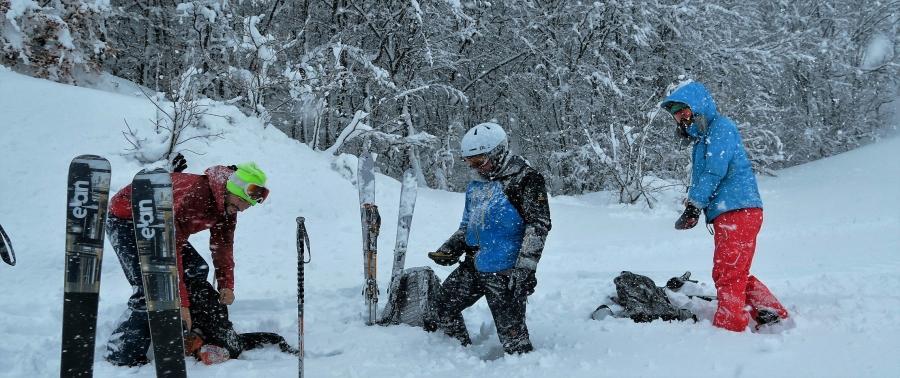Mother nature provides us with 5 warning signs of high avalanche risk.
All backcountry skiers should be on the look out for the presence of one or more of these signs. The more flags that are present, the higher the risk of an avalanche. The presence of these dangers doesn’t necessarily mean that off-piste skiing is cancelled for the day, but it will mean that your ski routes will need to be planned accordingly, with the risk firmly in mind.
Remember, aspect, altitude and time of day are critical variable when judging avalanche risk at a given place, so conditions which manifest in one location may be totally different to another location. Also timing is crucial, throughout the day avalanche risk can rise and fall dramatically with changing temperatures. This is especially the case in spring.
Here are the 5 red flags, remember them, and always be on the look out.
Recent avalanche activity.
This simple rule is often overlooked! Evidence of recent avalanches, is an indisputable sign of instability. When making observations always take care to scan the whole of the visible landscape. If there is evidence of recent slides, take careful note of the aspect, altitude, type of avalanche (i.e. slab, wet snow slide, slough or layer failure). It is possible to gauge the age of the slide by examining the freshness of the debris.
As a general rule, if you see recent avalanche activity, the snowpack is unstable.
Cracking, Blocking or Whooping of the Snow Pack
Cracking and blocking indicate the presence of wind slab, which is an unstable form of snow. Wind slab is formed by the wind driving together the snow particles into a homogenous mass which can propagate over a wide area. Always be on the lookout for cracks under the skis. If you see extensive cracking or ‘shooting cracks’, this indicates extreme instability, so get off the slope.
A "whoomping" sounds coming from within the pack itself means that a weak layer is collapsing and that the snowpack is unstable. Usually this sound is triggered by the weight of the skier. This warning sign can be particularly relevant when there has been significant new snow on the top of an older pack which has turned ‘sugary’. Whoomping is a sure sign to stay off steep slopes.
Significant Snowfall in the last 24 Hours
New snow hasn’t had any time to bond or compact so is inherently unstable. In addition, a lot of avalanches are triggered by skiers on the first day after snowfall because people are keen to get fresh tracks in the new snow. The combination of significant new snow accompanied by wind is recipe for wind loading and instability.
It is also worth noting that significant rain on top of the snow raises the chances of wet snow slides.
Strong Winds
Unstable wind slabs are created by strong winds. Wind blown snow is compacted and bonded by the wind. If the wind is blowing or has blown recently it has probably created dangerous slabs and increased the avalanche danger. The wind is most relevant during or soon after significant snow. However wind slabs can still form at any time, due to the transportation of particles from the windward aspects to sheltered aspects. Wind slab deposits are usually found on the leeward or sheltered side of prominent terrain features such as ridges, peaks and passes. This is called ‘top loading’. But wind can also blow across a slope which is called ‘cross loading’. Wind slabs are usually found at higher elevations.
Temperature Rise
If the temperature is on the rise, then beware! Especially later in the ski season it will be cold powder skiing in the morning and then warm up significantly in the afternoon. Along with the rise in temperature comes rapid changes within the snow pack. Rising temperatures cause partial melting and lubrication within the snow structure. The snow becomes both heavier and more mobile. If temperatures rise significantly above zero then the snow becomes saturated and wet slides could occur. Rolling balls, and point releases all indicate wet unstable snow. It is worth noting that direct sunlight leads to a rapid temperature increase especially on southerly and westerly slopes even when the air (shade) temperature stays below zero.
Ski Safe
 Off-Piste
Off-Piste Ski Touring
Ski Touring Via Ferrata
Via Ferrata Ice Climbing
Ice Climbing Alpine Glacier Trekking
Alpine Glacier Trekking Worldwide Trekking
Worldwide Trekking




 Travel Website Development
Travel Website Development